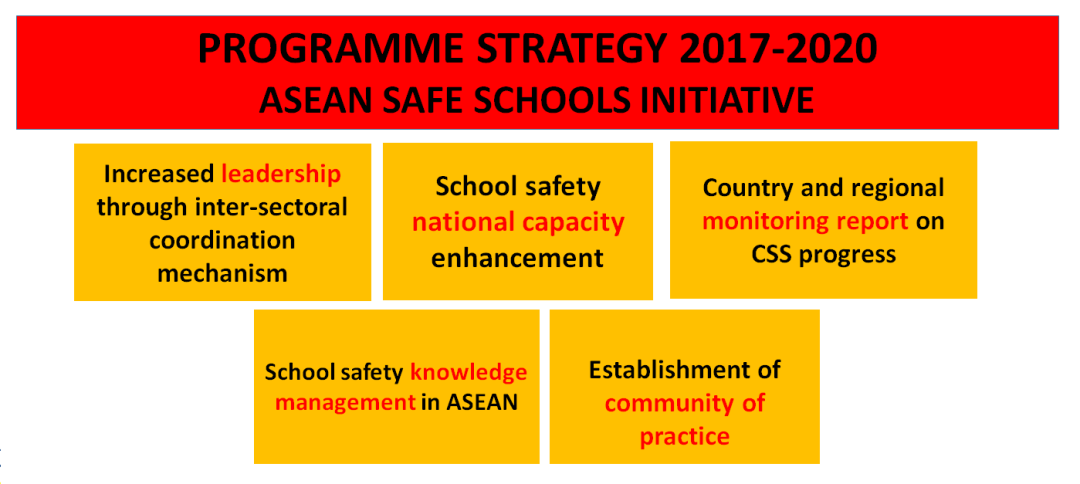ASSI Programme Strategy

The ASSI Programme Strategy 2017-2020 is generally guided by the following underpinning technical thrusts:
-
Supporting development of a member-state-driven inter-sectoral leadership and coordinating structure for ASSI:
- Support the establishment of an inter-sectoral coordinating body or mechanism for school safety in ASEAN (i.e. Education Sector and Disaster Management Sectors, as well as other stakeholders);
- Identify and support school safety focal points from the MOEs and NDMOs in ten AMSs.
-
Strengthening National Capacities on School Safety:
- Conduct capacity-building on school safety for educational authorities, NDMOs and other relevant government offices including training on Comprehensive School Safety (CSS); CSS Assessment; Safer Learning Facilities, and School Disaster Management (e.g. through distance learning and/or face-to-face learning);
- Strengthen national (especially provincial and school-level) capacities on CSS through development or enhancement of innovative tools and resources;
- Establish strategic partnerships with relevant agencies (i.e. Southeast Asian Ministries of Education Organisation (SEAMEO) research and training centers, etc.) to build ASEAN capacity on CSS.
-
Facilitating and supporting the country and regional monitoring and assessment of CSS progress using identified CSS indicators:
- Support the establishment of regional and national reporting guidelines/mechanism for school safety reporting to the AADMER, ASEAN Work Plan on Education, Worldwide Initiative for Safe Schools, and Sendai Framework on DRR (SFDRR) including disaggregated data based on sex and gender in school safety reported to ASEAN
- Promote School CSS self-assessment (piloted in Lao PDR) and other innovative tools based on country context
- Promote the wider use of a School Facilities Assessment tools (e.g. Visual Inspection for defining Safety Upgrading Strategies (VISUS) tool piloted in Lao PDR and Indonesia) to contribute in ensuring safer learning facilities in the region
-
Building Communities of Practice
- Establish a regional pool of trained experts and practitioners on various aspects of school safety through trainings, and promotion and recognition of regional school safety champions
- Foster networks and partnerships on school safety in the region
- Organize knowledge exchange among AMSs and other regional stakeholders
-
Information and Knowledge Management
- Promote innovation and technology to foster and promote school safety
- Conduct and share evidence-based research and case studies
- Enhance accessibility and availability to safe schools related information through web portal, reader friendly material (i.e. appropriate languages and sensitized to age and gender)
- Develop key messages, transfer of information, communication materials
